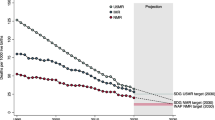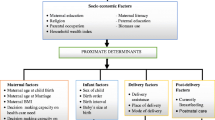Abstract
National Family Health Survey (NFHS)-4 report was recently released for health-related data. This review compares the child health indicators across NFHS-3 and NFHS-4 with a background of existing health programs catering to child health. Reports of NFHS-4 and NFHS-3, along with ministry reports and existing literature were reviewed to understand the current status of child health. Child health indicators were compared between the two rounds of NFHS and among Empowered Action Group states of India. National Health Policy 2017 and National Health Programs related to child health were also analyzed. There has been an improvement in almost all child health indicators from NFHS-3 to NFHS-4. The infant mortality rate has reduced to 41 per 1000 live births. The immunization rate is 62%, and has almost doubled in the states of Uttar Pradesh, Rajasthan and Madhya Pradesh. Despite existence of many health programs, there is still a substantial lack of achievement in most of the indicators.
Similar content being viewed by others
References
Indian Institute for Population Sciences (IIPS) and MoHFW. National Family Health Survey -4. 2017. Available from: http://rchiips.org/nfhs/pdf/NFHS4/India.pdf. Accessed June 12, 2017.
Indian Institute for Population Sciences (IIPS) and MoHFW. Key Indicators for India from NFHS-3. Vol. 18. Available from: http://rchiips.org/nfhs/pdf/India.pdf. Accessed June 12, 2017.
Ministry of Health and Family Welfare. Home Based Newborn Care;Operational Guidelines. 2014; (Revised). Available from: http://nhm.gov.in/images/pdf/programmes/child-health/guidelines/Revised_Home_Based_New_Born_Care_Operational_Guidelines_2014.pdf Accessed July 24, 2017.
Ministry of Health and Family Welfare, Governent of India. Natonal Health Mission. Janani Suraksha Yojana. Available from: http://nhm.gov.in/nrhm-components/rmnch-a/maternal-health/janani-suraksha-yojana/background.html. Accessed May 12, 2017.
Gupta SK, Pal DK, Tiwari R, Garg R, Shrivastava AK, Sarawagi R, et al. Impact of Janani Suraksha Yojana on institutional delivery rate and maternal morbidity and mortality: An observational study in India. J Heal Popul Nutr. 2012;30:464–71.
Vora KS, Koblinsky SA, Koblinsky MA. Predictors of maternal health services utilization by poor, rural women: a comparative study in Indian States of Gujarat and Tamil Nadu. J Health Popul Nutr. 2015;33:9.
Ministry of Health and Family Welfare, Governent of India. NHM. Guidelines for Janani Shishu Suraksha Karyakram 2011. Available from: http://nhm.gov.in/images/pdf/programmes/guidelines-for-jssk.pdf. Accessed July 24, 2017.
Immunization Division/MOHFW. Universal Immunization Program. 2013;20. Available from: http://mohfw.nic.in/WriteReadData/l892s/Immunization_UIP. pdf. Accessed July 24, 2017.
UNICEF. Coverage Evaluation Survey 2009, All India Report. Ministry of Health and Family Welfare, Government of India, New Delhi; 2010. 2011. Available from: http://hshrc.gov.in/wp-content/uploads/National_Fact_Sheet_CES_2009.pdf. Accessed June 07, 2017.
Governent of India. Mission Indradhanush. Available from: http://www.missionindradhanush.in. Accessed July 27, 2017.
Government of India. National Health Policy 2017. 2017;1-31. Available from: http://www.mohfw.nic.in/showfile.php? lid=4275. Accessed July 27, 2017.
Lamberti LM, Walker CLF, Noiman A, Victora C, Black RE. Breastfeeding and the risk for diarrhea morbidity and mortality. BMC Pub Health. 2011;11:S15.
Kornides M, Kitsantas P. Evaluation of breastfeeding promotion, support, and knowledge of benefits on breastfeeding outcomes. J Child Health Care. 2013;17:264–73.
World Health Organization. Infant and young child feeding. 2009;2:3-4. Available from: http://www.who.int/mediacentre/factsheets/fs342/en/. Accessed July 27,2017.
Ministry of Health and Family Welfare,Governement of India. NHM. Mother’s Absolute Affection (MAA) Programme for Promotion of Breastfeeding. 2016:1-26. Available from: http://www.nhm.gov.in/MAA/Operational_Guidelines.pdf. Accessed July 27, 2017.
Chudasama RK, Kadri AM, Verma PB, Patel U V, Joshi N, Zalavadiya D, et al. Evaluation of integrated child development services program in Gujarat, India. Indian Pediatr. 2014;51:707–11.
Governement of India. National Programme of Nutritional Support to Primary Education, 2006 [ Mid-Day Meal Scheme ] GUIDELINES. 2006; Available from: http://www.schooleducation.kar.nic.in/mms/mmspdfs/mdmguidelines_dec 2006.pdf. Accessed July 27, 2017.
Ministry of Health and Family Welfare,Government of India. Operational Guidelines on facility based management of children with severe acute malnutrition. 2011. Available from: http://nhm.gov.in/images/pdf/programmes/childhealth/guidelines/operational_guidelines_on_fbmc_with_sam.pdf. Accessed July 27, 2017.
Burza S, Mahajan R, Marino E, Sunyoto T, Shandilya C, Tabrez M, et al. Community-based management of severe acute malnutrition in India: new evidence from Bihar. Am J Clin Nutr. 2015;101:847–59.
National Health Mission. Available from: http://nhm.gov.in/nhm.html. Accessed July 27, 2017.
Narwal R. Success and Constraints of the National Rural Health Mission. Available from: https://www.research gate.net/profile/Rajesh_Narwal/publication/283986277_Success_and_Constraints_of_the_National_Rural_Health_Mission_Is_there_a_Need_for_Course_Correction_for_India’s_Move_towards_Universal_Health_Coverage/links/564aa7cd08ae295f644fec48.p. Accessed July 21, 2017.
World Bank Goup. Health expenditure, total (% of GDP). 2017. Available from: http://data.worldbank.org/indicator /SH.XPD.TOTL.ZS. Accessed June 07, 2017.
World Health Organisation. Health Financing Strategy for Asia Pacific Region (2010-2015). 2009. Available from: http://www.wpro.who.int/publications/docs/Health financingstrategy_6188.pdf. Accessed June 07, 2017
Mcintyre D, Meheus F, Røttingen J-A. What level of domestic government health expenditure should we aspire to for universal health coverage? Heal Econ Policy Law. 2017;12:125–37.
Ministry of Health and Family welfare. Government of India. Situational Analysis. Backdrop to the National Health policy. 2017. Available from: http://www.the hinducentre.com/multimedia/archive/03145/Situation_Analyses_3145486a.pdf. Accessed June 07, 2017.
Author information
Authors and Affiliations
Corresponding author
Rights and permissions
About this article
Cite this article
Dhirar, N., Dudeja, S., Khandekar, J. et al. Childhood Morbidity and Mortality in India — Analysis of National Family Health Survey 4 (NFHS-4) Findings. Indian Pediatr 55, 335–338 (2018). https://doi.org/10.1007/s13312-018-1276-6
Received:
Revised:
Accepted:
Published:
Issue Date:
DOI: https://doi.org/10.1007/s13312-018-1276-6




